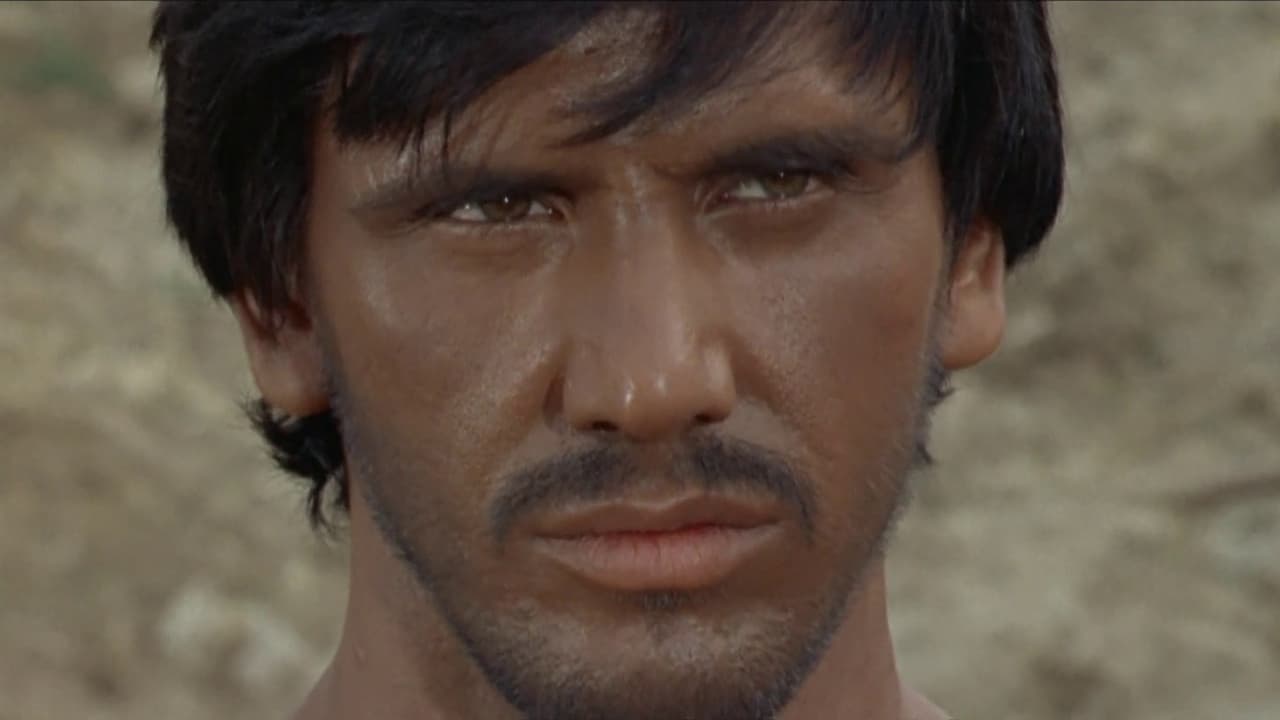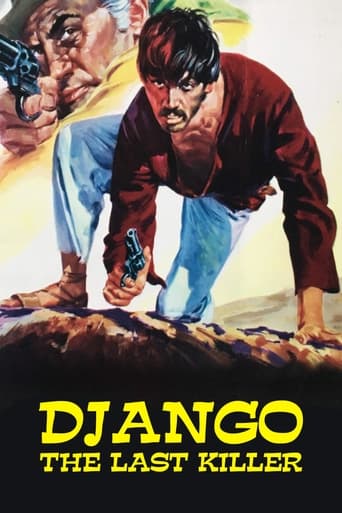

At first rather annoying in its heavy emphasis on reenactments, this movie ultimately proves fascinating, simply because the complicated, highly dramatic tale it tells still almost defies belief.
... View MoreEach character in this movie — down to the smallest one — is an individual rather than a type, prone to spontaneous changes of mood and sometimes amusing outbursts of pettiness or ill humor.
... View MoreA film of deceptively outspoken contemporary relevance, this is cinema at its most alert, alarming and alive.
... View MoreThe movie really just wants to entertain people.
... View MoreRamón (George Eastman) is a young Mexican attempting to live a peaceful life along with his daddy (John McDouglas) but they are eventually harassed by hoodlums . Once time he finds that his father has been murdered and his nemesis results to be a powerful land baron called John Barrett (Daniele Vargas) . Barrett is a nasty owner who threatens and coerces townsfolk and obligates countrymen to leave their lands to take for him . Meanwhile Djanjo or Rezza or Rocco (Dragomir Bojanic-Gidra as Anthony Ghidra) settles a dispute between bands of cutthroats , then Ramon or ¨Chico¨ helps him and saves his life . As Ramon befriends a veteran gunfighter Django (Anthony Ghidra) who at the same time has been contracted by Barrett as the hired gun to kill ¨Chico¨ . Thanks to Rezza or Rocco , ¨Chico¨ learns the art of gun-play and he , then , goes out to avenge his killed dad , embarking on a line of crime , battling murderous and executes a single-handedly revenge , as he shoots , ravages and kills each person involved in the murder .This exciting Spaghetti contains noisy action , thrills , shootouts and turns out to be an acceptable Western and entertaining enough . The picture es starred by George Eastman or Luigi Montefiori along with his master of arms , the Yugolavia-born Dragomir Bojanic-Gidra , nicknamed under pseudonym as Anthony Ghidra who also interpreted some Westerns . At the beginning his career , Luigi starred as an extra but Italian westerns soon followed , usually under the pseudonym "George Eastman" . He once reportedly missed out on a role in a Franco Nero western because his height made Franco Nero look too short . As he performed several Pasta Westerns , such as : ¨Django Taciturno¨, "Django Sees Red" , ¨Keoma¨ , "Humpty Dumpty Gang" , "The Unholy Four" , and "The Three Musketeers of the West". Never quite "typed" , Luigi played some of them as main actor , others as secondary player . Soon moved into other film genres playing good guys , bad guys, and good-bad guys . These parts often exploited his athletic physique by having him remove his shirt, perhaps most memorably in Lina Wertmüller's Belle Starr (1968) . Support cast is plenty of familiar faces from Spaghetti Western , such as : Daniele Vargas , Mirko Ellis , Dana Ghia , John Hamilton and Giuseppe Addobbati or John McDouglas . Emotive as well as thrilling musical score by Roberto Pregadio , this soundtrack is one of the best parts of the film , plenty of catching and attractive sounds . Colorful and evocative cinematography by Angelo Filippini . Produced by Sergio Garrone who also directed some Westerns , the yarn was well directed by Giuseppe Vari , nicknamed as Joseph Warren . Vari was a good professional , a nice craftsman who directed various films of all kinds of genres such as : Sci-Fi : Urban Warriors ; Warlike : Revenge of the bloody beach ; Nunexploitation : Sor Emmanuel ; Peplum : Revenge of the Barbarians , Rome versus Rome , Conquest of the Normans , and specially Spaghetti such as : 1971 Il Tredicesimo è Sempre Giuda , 1969 Un Posto all'inferno , 1968 Un Buco in Fronte , 1967 Con Lui Cavalca la Morte , 1967 Un poker Di Pistole , 1967 The last gunfighter and 1966 Deguello .
... View MoreRamon, a peasant farmer, is suffering under the thumb of the greedy land baron Mr. Barrett. He has been beaten and run out of town by Barrett's henchmen. Worse, he has seen his family farm burned; his elderly father killed. On the outskirts of town, he comes across the solitary hit-man known as Django, another man with no place in Barrett's town. The two strike up a friendship, with the elder gunman teaching Ramon the ways of the gunslinger. Eventually, will each man settle a score with Barrett and possibly with each other? This modestly-plotted western by Joseph Warren/Giuseppe Vari features some nice dramatic action at the beginning and end of the film; with a long, deliberate middle section detailing the grudging friendship between the two outcasts. Despite a simple story, the film is engaging and brisk, a solid "programmer"-type picture.Ramon is played by George Eastman, a tall, lanky Italian who bears more than a passing resemblance to Tomas Milian. Ramon is a generally decent, gentle but proud peasant who resorts to violence not as a matter of course, rather, only when he is pushed to his emotional limit by cruel, evil men. Probably safe to say that by 1967, when this film was made, the "Tomas Milian" type was already emerging as a western archetype, and Eastman plays to that standard. That said, Eastman's depth of charisma and ability to channel emotions, while passable, cannot match the natural ability of Milian. Much like every squinty-eyed loner was compared to Eastwood; every peasant turned violent would be matched against Tomas Milian.As the gun-toting loner Django, we have Lorne Greene look-alike Anthony Ghidra. Ghidra's Django is not the miserable black-clad outcast as is often seen; the character here is a handsome, well-kept loner with a stiff upper lip and stylish neck scarf. The portrayal is that of a resigned, world-weary soul that would rather stroll the streets of his hometown than commit murders-for-hire. Ghidra is good in the part. He spouts the philosophies and axioms of the Gunfighter's Way in a sincere fashion; a lesser actor might have sounded ridiculous saying this dialogue, but Ghidra pulls it off with straight-faced charm. (Apparently the name Django was added to the character after the fact for marquee value – in the original Italian version Ghidra's character is called Rezza. That explains the un-Django-like mannerisms and wardrobe.) Daniele Vargas as Barrett provides the film with its villain, and he is a good one, all smug and cowardly as greedy land barons all seem to be. On hand as Barrett's love interest and the girl from Ramon's past is Dana Ghia as Lola, strikingly attractive and effective in her small role.Director Giuseppe Vari, billed as Joseph Warren, keeps the slow middle section of the picture engaging despite little action. Notable is a series of "Karate Kid"-style training sequences in which Ramon learns to handle a gun. During the initial "in-town" setup of the story, Vari utilizes a few quick zooms and cuts here and there to increase dramatic tension; at other times (the "outskirts" scenes) he languidly captures some nice wide vistas. The look of these latter scenes is great, with especially bright blue skies and green trees laid bare.The score, by Roberto Pregadio, is particularly unmemorable. In fact, as I type, I cannot recall a single theme or musical motif. Guess that's better than a terrible score.The film is in public domain, and is readily available to view in full on YouTube and other similar sites. As a run-of-the-mill "programmer"-type of Eurowestern, with no real star power to boost it, THE LAST KILLER is still pretty good. It is never boring, is ably acted and directed, and is pleasingly photographed. 7/10 stars.
... View MoreAs you probably know, there were a number of spaghetti westerns that capitalized on the success of DJANGO, namely by renaming (during the dubbing) of characters to the name of "Django", as they did with this movie. (At least they didn't try to further the ripoff here by having the Django here dress in black and carry a machine gun, as some other films did.) Anyway, this spaghetti western is not without flaws. It's more leisurely paced than other spaghetti westerns - it takes more than 30 minutes for Eastman's character and "Django" to meet, and Eastman's training takes a considerable amount of time. Some viewers may squirm in their seats at some point. His quest for revenge is almost forgotten about along the way. The "surprise" twist that happens late in the movie will probably be no surprise to most viewers.On the other hand, the production values (sets, photography, etc.) are decent, there is some good and atypical location work (green fields instead of desert), the bad guys are hateful enough, the musical score by Roberto Pregadio is first rate, and there is some interesting dialogue. No, this movie is not a classic of the genre, and certainly won't convert newbies to the genre, but if you like spaghetti westerns like me, it is acceptable.
... View MoreA cut-rate Spaghetti Western which recalls superior titles like THE RETURN OF RINGO (1965), THE BIG GUNDOWN (1966) and DEATH RIDES A HORSE (1968) but which is so humorless and, indeed, ponderous as to be hilarious - particularly the would-be hard-boiled dialogue, i.e. two speeches delivered by the hero's father (about the desolate state of their land before his arrival) and his bounty hunter-mentor (about the trick in approaching a showdown); my favorite, however, is when the chief villain's lieutenant stands up to his boss with the preposterous line: "I know you like I know the odor of my feet!"; at least, the music score by Roberto Pregadio is nice...
... View More